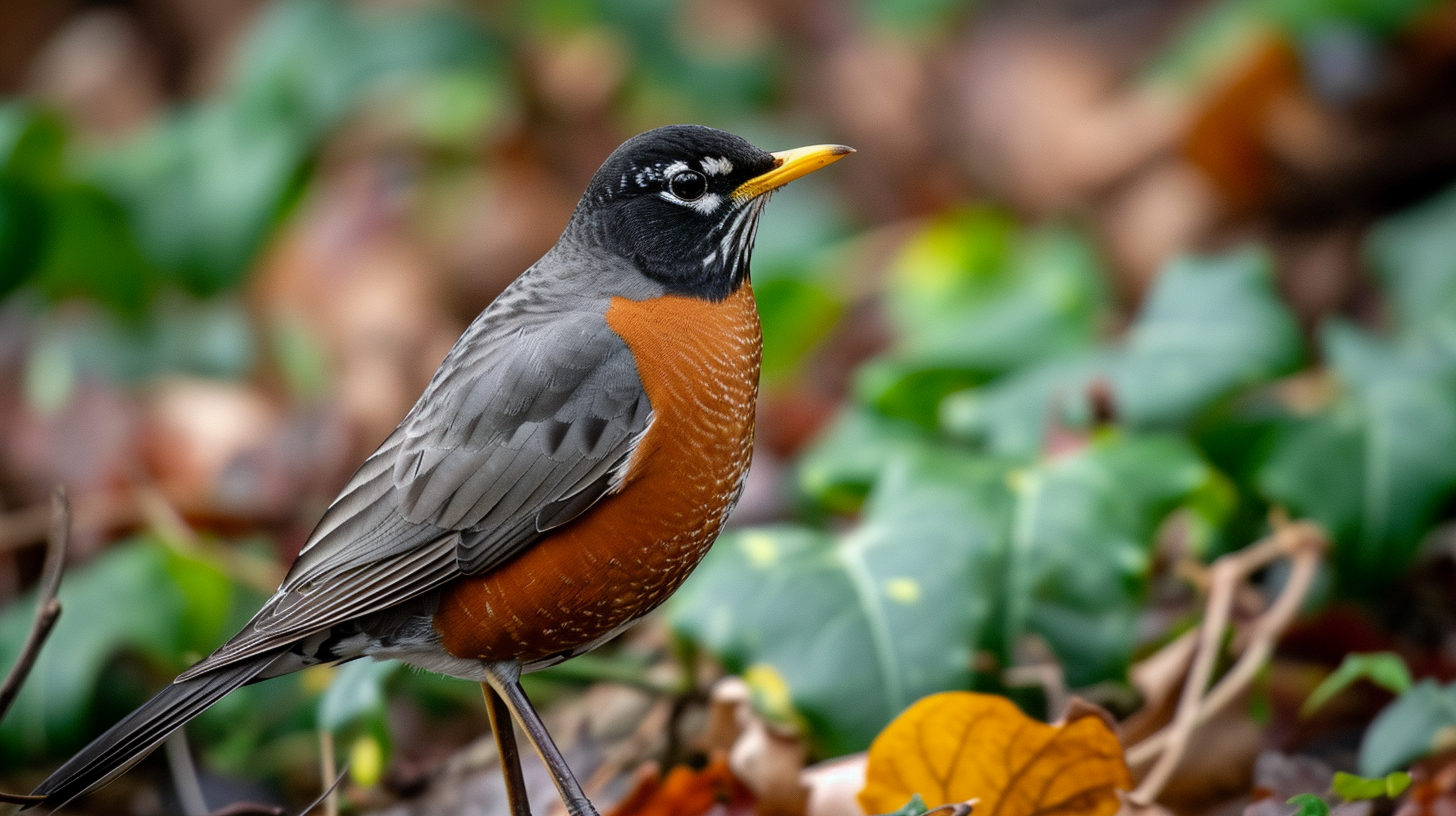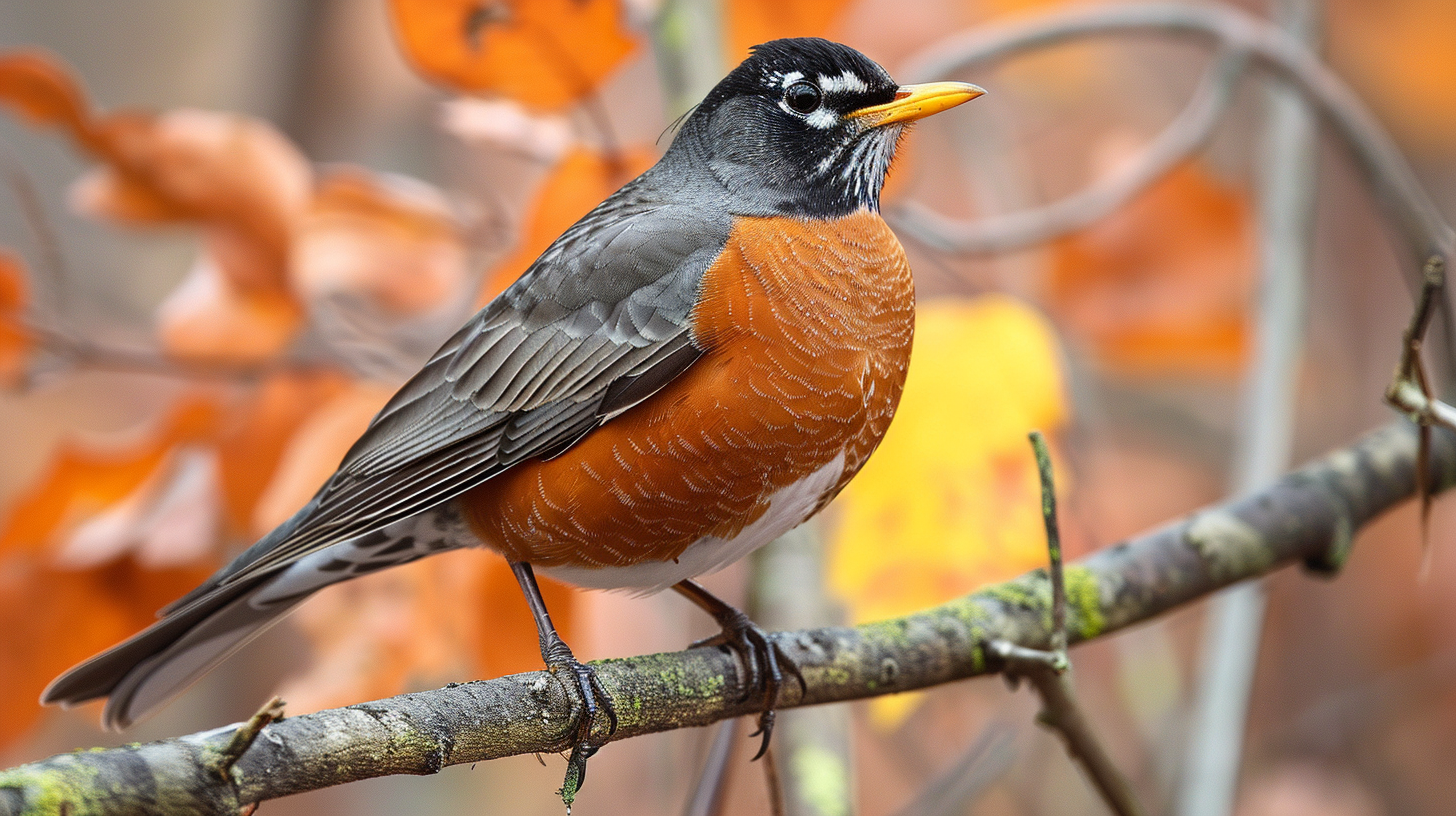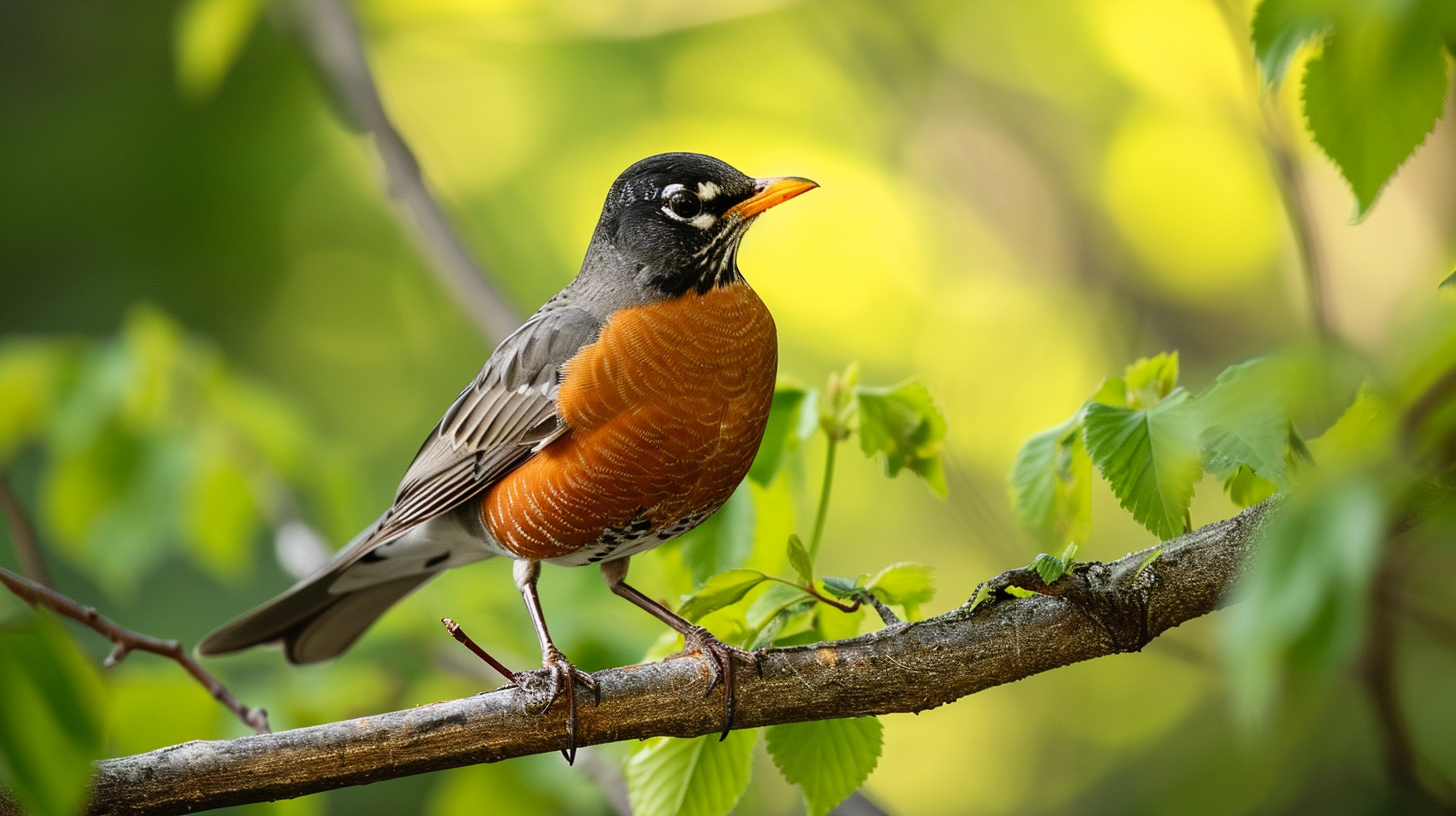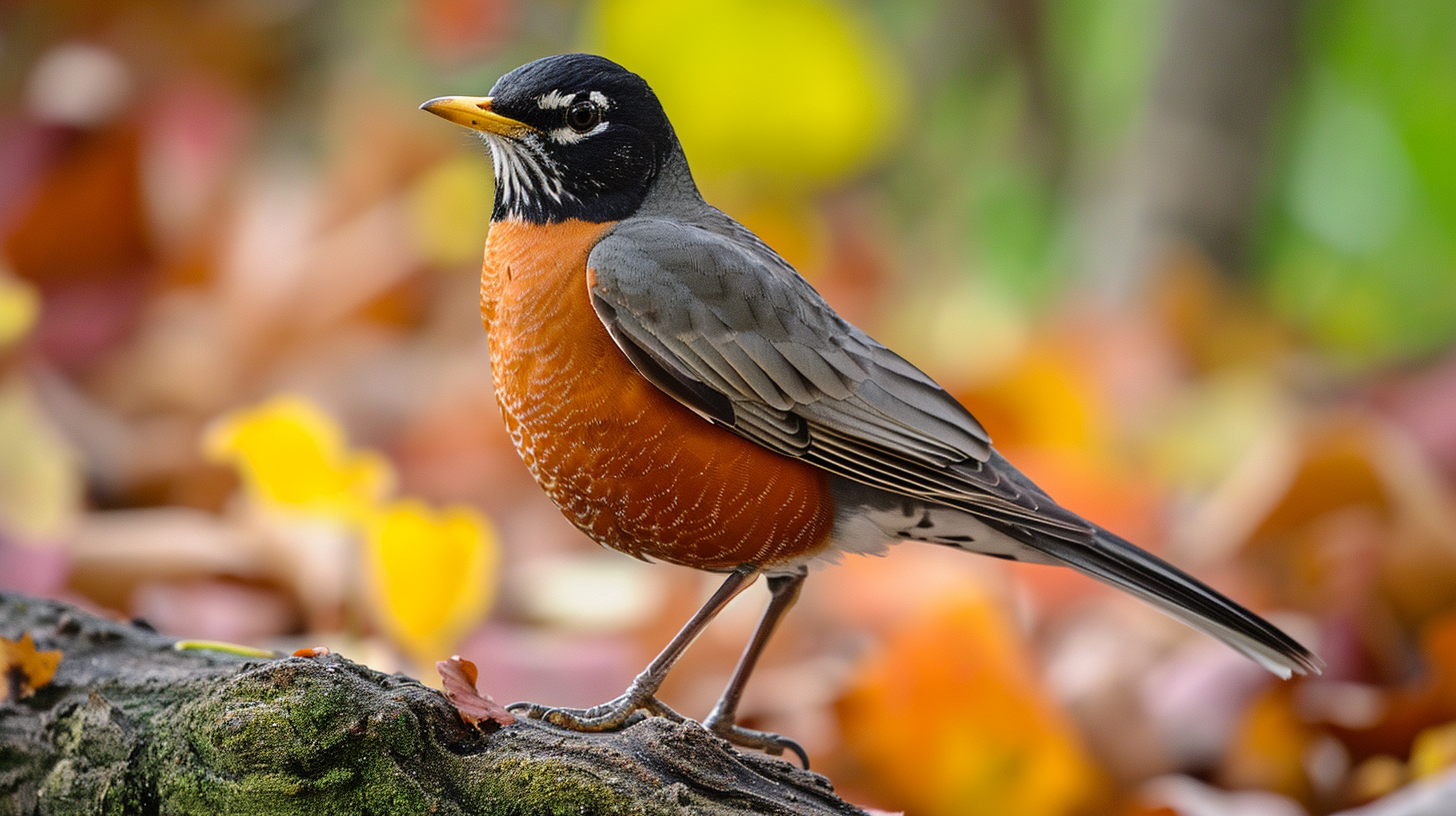Welcome to the ultimate guide to American Robins! If you’re a bird enthusiast or just curious about these feathered creatures, you’ve come to the right place.
In this comprehensive guide, we’ll cover everything you need to know about American Robins – from their habitat and behavior to their unique characteristics and fun facts.
If you’ve ever been intrigued by the sight of these red-breasted birds hopping around your yard or park, this guide is for you.
We’ll dive into the fascinating world of American Robins and explore their role in our environment. So let’s get started and discover all there is to know about these iconic birds!

What Is An American Robin?
The American Robin, scientifically known as Turdus migratorius, is a migratory songbird that holds a beloved place in North American wildlife.
It is part of the thrush family, Turdidae, and is distinguishable by its warm orange breast.
- Size & Appearance:
- Class: Aves
- Order: Passeriformes
- Family: Turdidae
- Length: Approximately 9 – 11 inches
- Weight: Roughly 2.7 – 3 oz
- Distinctive Markings: Reddish-orange chest, yellow bill, black head, and a white eye ring in males.
As you observe these birds, you’ll notice that males are typically more brightly colored than females, showcasing a darker head and more vivid chest.
Robins are quite adaptable and are frequently seen foraging on lawns, gardens, and parks, making them a familiar sight across the continent.
- Behavior:
- Diet: Primarily earthworms, insects, and fruit.
- Habitat: Varied, including forests, fields, and urban environments.
- Migration: Seasonal, with northern populations moving south for the winter.
American Robins are well-known for their melodious songs which are often linked to the arrival of spring.
They run and hop with an upright stance across the lawns and are sometimes found in large groups during the fall and winter months.
Although the American Robin shares its name with the European Robin, they are not closely related, highlighting the uniqueness of Turdus migratorius among thrushes.
How Many Types Of American Robin Are There?
The American Robin, known scientifically as Turdus migratorius, is a single species with no recognized subspecies; therefore, you won’t find types differing in genetic makeup.
However, you may observe slight regional variations in color and size across their range that some birders informally note, though these do not constitute different types.
Size and Coloration: When you observe American Robins, take note that the birds are generally consistent in appearance with the familiar reddish-orange breast, gray back, and white undertail coverts. Some robins may appear slightly paler or darker, influenced by factors such as age and molting cycle, but these variations don’t signify different types.
Similar Species: While there are other birds that may look similar to American Robins, it’s important to distinguish that these are separate species and not types of robins. For instance:
- Wood Thrush (Hylocichla mustelina): Slightly smaller, with a spotted breast.
- Swainson’s Thrush (Catharus ustulatus): Smaller, with buffy eye-ring and breast streaks.
- Varied Thrush (Ixoreus naevius): Similar size, but with distinct bold black and orange patterning.

What Does An American Robin Sound Like?
American Robins are distinguished by their vocalizations that can be heard especially in the springtime.
Their songs typically consist of a series of clear whistles which may remind you of the words “cheerily, cheer up, cheer up, cheerily, cheer up”.
This song is delivered in a rhythmic pattern, with each syllable holding a distinct rise and fall in pitch, but maintaining a steady tempo.
The calls of the American Robin serve various purposes, from alarming others of potential danger to attracting a mate. Here are common calls you might hear:
- “Tic” or “Tut” sounds: These are often used as a contact call or mild alarm.
- “Whinny” call: This may indicate distress or agitation.
As you tune into these sounds, understanding them can give you greater insight into what the American Robins around you are communicating.
Listening closely might even allow you to distinguish between a robin bird that is simply singing its heart out from one that is sounding an alert.
Here’s a quick reference:
| Call Type | Description | Purpose |
|---|---|---|
| Song | A string of clear whistles | Mating, Territorial |
| Tic/Tut | Short, sharp notes | Contact, Mild Alarm |
| Whinny | Higher-pitched undulating whistle | Distress, Strong Alarm |
| Squee | High-pitched sound | Excitement, Fear |
Familiarize yourself with these sounds and soon you might find that you can understand the basic “language” of the American Robins in your area.
What Does An American Robin Look Like? What’s Their Wingspan?
When you observe an American Robin, you’ll notice its distinctive orange breast, which serves as a stark contrast to its gray back and gray wings.
The intensity of the orange hue can vary, but it’s typically a vibrant, warm shade that’s easy to spot.
Males and females look similar but can be differentiated by subtle differences. The male generally has a darker head and richer orange on the breast, while the female’s colors are paler.
The wingspan of the American Robin is an important characteristic, lending to its recognizable silhouette in flight. You can expect it to span approximately:
| Age Group | Wingspan Range |
|---|---|
| Adult | 12-16 inches |
Robins are not just admired for their colors but also for their feathers, which on closer inspection, show a fine, detailed patterning that aids in camouflage and temperature regulation.
Their wings, besides providing flight, also play a key role in body language and display during social interactions.
Where Are American Robins Most Commonly Found?
American Robins have a versatile presence across North America. You can spot these birds in a diverse array of habitats ranging from the dense woodlands to suburban backyards.
They are a frequent sight in both city parks and expansive forests, showcasing their adaptability.
In fields and grasslands, American Robins forage for food, making these areas ideal for bird watchers. They gracefully hop and run across the land, searching for earthworms and insects.
If you’re in a more urban setting, you can observe them skillfully navigating city parks, where they nest and feed.
During summer, some of these robust travelers migrate to northern regions, including parts of Alaska and Canada. Here, they take advantage of the rich breeding grounds.
- Habitat: Woodlands, parks, backyards, grasslands, fields
- Presence in North America: Year-round, widespread
- Migration: Northern movement to Alaska and Canada during summer
Robins are hardy creatures, braving even the colder climates as long as food resources are ample. Next time you’re outdoors, keep an eye out—American Robins are likely not far away.
Their presence is a sign that you are in a space that supports this bird’s varied nesting and feeding requirements.

What Do American Robins Symbolize?
The American Robin, with its recognizable red breast and cheery song, holds a significant place in various cultural narratives.
For you, these birds may symbolize a variety of concepts, often tied to their behavior and seasonal patterns.
Renewal and Hope: Traditionally, the American Robin heralds the arrival of spring. As the landscape thaws and flowers bloom, the robin’s presence underscores a period of refreshing change. You may view this as a natural sign of optimism and new beginnings.
Fertility and Growth: Because American Robins are active during the time of year when nature is reawakening and fertile, they often represent growth and development. This mirrors the natural world’s cycle where life burgeons anew in spring.
| Symbolic Attributes | Associated With American Robin |
|---|---|
| New Beginnings | Arrival in spring |
| Hope | Singing at dawn |
| Renewal | Re-emergence of life in nature |
| Growth | Nesting and raising young |
| Vitality | Bright, red breast |
In Native American culture, your connection to American Robins may be steeped in symbolism as messengers or signs of divine forces at work.
The bird’s diligent nature and the careful construction of its nest serve as reminders for you to take joy in work and creation.
What Is The Diet Of American Robins?
Your curiosity about the diet of American Robins reveals a varied menu that extends beyond the common earthworm.
As insectivores and frugivores, these birds have a diet composition that includes:
- Invertebrates: Robins forage for earthworms, grubs, and snails, making up a significant portion of their diet.
- Insects: Their diet is rich in various insects such as beetles, caterpillars, and aquatic insects.
- Berries and Fruit: When available, robins won’t shy away from berries like chokeberries, juniper berries, and sumac fruits, as well as various fruits that contribute to their diet.
Their foraging habits are a sight to behold; you might catch them listening for earthworms beneath the soil before deftly plucking them out.
Seasonal changes influence their foraging patterns; they tend to eat more animal prey during breeding season and more plant material, like hawthorn berries, towards the winter months.
Here is a simplified breakdown of their dietary preferences:
| Food Category | Examples |
|---|---|
| Invertebrates | Earthworms, grubs, snails |
| Insects | Beetles, caterpillars, spiders |
| Berries | Chokeberries, juniper berries |
| Fruits | Hawthorn, sumac fruits |
To maintain their energy, robins adapt and switch between these food sources, often seen hopping on your lawn in a relentless quest for nourishment.
Do American Robins Have Any Predators?
American Robins, recognizable by their distinctive orange breasts and melodic songs, are subject to predation from a variety of animals.
You will find that certain birds of prey, specifically hawks, are formidable predators capable of snatching robins from the sky or ground.
The presence of hawks can pose a great risk, especially to unsuspecting robins foraging in open spaces.
Land-based predators are also a threat. Feral and domestic cats are skilled hunters that can catch robins off guard in urban or suburban settings.
In natural habitats, snakes can be a menace, especially to nestlings and eggs. Even small snakes have been known to attack juvenile robins or consume their eggs.
In addition to these predators, American Robins must also be vigilant of other threats, including:
- Squirrels: These nimble creatures can raid robin nests and consume eggs or nestlings.
- Shrews: While smaller, shrews can be opportunistic feeders and may target eggs or young robins.
While American Robins are proficient at defending themselves through various methods, such as alarm calls and safeguarding their nests by building them in concealed locations, they are still vulnerable to a range of natural predators.
Their vigilance and adaptive behaviors contribute to their survival amidst these challenges.

Where Do American Robins Nest?
American Robins are resourceful birds when it comes to selecting a nesting site. As you observe these birds, you’ll notice that robins favor sheltered locations that provide safety and warmth for their offspring.
When they begin the nesting process, these birds construct their homes using a mixture of mud, twigs, and moss.
Their architectural choices are admirable, as the mud provides a solid base, while the twigs create structure, and the moss adds a soft lining for the eggs.
Common nesting sites for American Robins include:
- Tree branches: Secure and elevated, away from many ground predators.
- Eaves and gutters of buildings: These man-made structures offer shelter from the elements and predators.
- Window sills and porch lights: These locations are often used in urban settings where natural sites are scarce.
Robins adapt their nesting habits to their environment, which includes a diverse range of both natural and man-made structures.
In the wild, a robin might choose a hidden spot in a bush or the fork of a tree. However, in urban areas, robins make use of buildings and other structures to support their nests.
Your presence around these nests should be minimized to avoid disturbing the robins and their brood.
Admire their nest-building skills and resourcefulness from a respectful distance, and you’ll be able to enjoy the beauty of their life cycle without interference.
When Do American Robins Lay Eggs?
American Robins engage in breeding activities primarily during the spring and early summer. You can expect these birds to lay eggs from April to July, when the conditions are suitable for raising their young.
The clutch, or group of eggs laid by a female robin, can range from 3 to 5 eggs.
These eggs usually have a distinctive blue-green hue, making them a familiar and charming sight. Each egg measures about 1 inch in length with a smooth, glossy surface.
During the incubation period, the female Robin diligently warms the eggs by sitting on them. This incubation stage is crucial for the development of the embryos inside the eggs and lasts for about 12 to 14 days.
Here’s a quick breakdown of the American Robin’s nesting timeline:
- Breeding Season: April to July
- Clutch Size: Typically 3-5 eggs
- Egg Description: Blue-green color, smooth and glossy surface
- Incubation Period: 12-14 days
Throughout this time, it’s essential for the nesting area to remain undisturbed to ensure the eggs’ safety and the forthcoming hatchlings’ survival.
Remember, while the sight of these eggs can be exciting, maintaining a respectful distance is imperative for the protection of the American Robin’s next generation.
How Can I Tell If An American Robin Is Male Or Female?
When observing American Robins, you might be curious to distinguish between male and female birds.
Their physical differences are subtle, but with a keen eye, you can identify their gender.
Key Differences:
- Breast Coloration: Male robins sport a vibrant orange on their breast, whereas the females have a comparatively paler shade.
- Head Coloring: Look at the head—males exhibit a darker head feathering that contrasts more sharply with their back feathers than females do.
Observational Tips:
- Throat Area: The throat of the male may appear darker with a richer black color, which can help in differentiation.
- Behavioral Clues: Although behavior should not be your sole indicator, as it’s not always conclusive, often the male is more territorial and may be observed defending its area more aggressively.
Remember, while these guidelines can assist you in identifying the gender of American Robins, variations in individual birds can sometimes make it challenging to be certain of their sex based solely on appearance.

How Long Do American Robins Live?
American Robins (Turdus migratorius), a familiar presence in many backyards and parks, have a lifespan that varies depending on several factors including environmental pressures and predation.
If you observe these birds over the years, you might wonder about their life history and population sustainability.
In the Wild:
- Average Lifespan: 2 years
- Maximum Recorded Age: 13 years and 11 months
It’s important to note that while the average lifespan seems short, this is largely due to high mortality rates in the robin’s first year of life.
Should they survive this critical period, their chances of living a longer life increase significantly.
In Captivity:
- Extended Lifespan: Life expectancy increases due to the reduced threats and controlled environment.
Population Factors:
- Juvenile Survival: Low; due to predation from animals like snakes, squirrels, and other birds.
- Adult Survival: Higher after the first year; contributions to overall populations are more significant.
| Age Period | Survival Probability | Impact on Population |
|---|---|---|
| First Year | Low | High mortality decreases population growth potential. |
| Post-First Year | Increased | Surviving adults contribute to population maintenance or growth. |
Your awareness of the American Robins’ life expectancy is enriched by understanding these life history nuances, which influence their overall populations.
Remember, early survival is pivotal for the longevity and health of the American Robin populations you enjoy watching.

5 Interesting Facts About American Robins
- Diverse Diet: You might notice American Robins on your lawn, tugging at earthworms; this is a favored food, especially in spring and summer. However, their diet is quite flexible. In fall and winter, they shift more towards fruit consumption, and can even become slightly intoxicated from fermented berries!
- Behavioral Tidbits: Observe American Robins closely, and you’ll see a range of behaviors. They are social birds, often found in flocks, but exhibit territoriality during breeding seasons. Parent robins are diligent, with both males and females caring for their chicks. These juveniles are known for their spotted plumage, differing from the adults’ reddish-orange breast.
- Nesting Habits: Robins typically form monogamous pair bonds each breeding season. Their nesting grounds can be quite versatile, from trees to building ledges. Each clutch usually contains 3-5 blue eggs, and it’s common for robins to produce several broods in a year.
- Roosting and Sleep: At night or outside of breeding season, robins may gather in large communal roosts to sleep. These gatherings can sometimes number in the thousands, offering warmth and safety in numbers.
- Range and Conservation: The American Robin is widespread across North America. They adapt well to both wild and developed areas, which has helped maintain stable populations. Despite their adaptability, habitat preservation remains essential for their conservation and that of other wildlife species.
